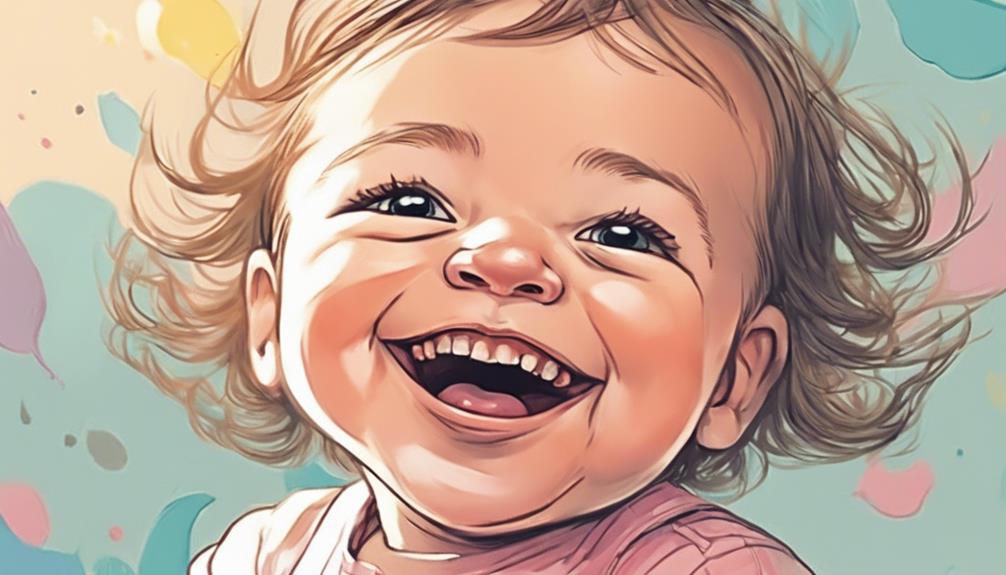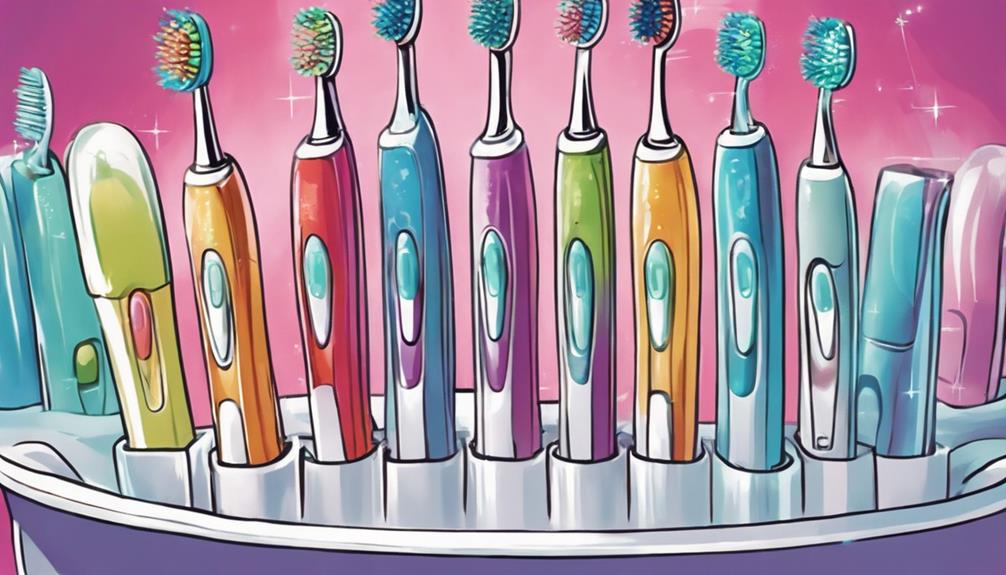Teeth in babies are the primary teeth that start to come in around six months, but they can emerge as early as three months or as late as twelve months. You'll notice signs like increased drooling, fussiness, and swollen gums during this process. The first teeth to appear are usually the lower central incisors, typically erupting between six and ten months. Establishing good oral hygiene from the start is essential for your baby's dental health. If you're curious about managing teething discomfort or learning about proper care, there's more valuable information just ahead.
Key Takeaways
- Baby teeth, also known as primary teeth, typically begin to erupt around 6 months of age.
- The first teeth to appear are usually the lower central incisors between 6 to 10 months.
- By age 3, children generally have a complete set of 20 primary teeth.
- Baby teeth are crucial for proper spacing of permanent teeth and assist in speech development.
Teething Overview
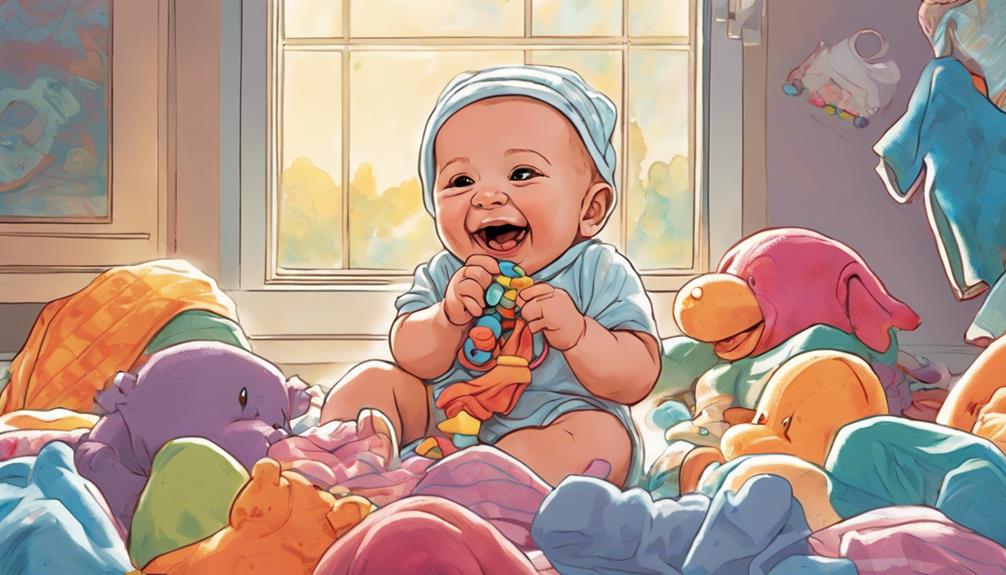
Teething is an exciting yet challenging milestone for you and your baby, typically starting around 6 months when those first little teeth begin to break through the gums. This process involves the emergence of baby teeth, also known as primary teeth, and it can begin as early as 3 months or as late as 12 months. You might notice symptoms like increased drooling, fussiness, and swollen gums, which are common signs of teething pain. Fortunately, this discomfort usually subsides once the tooth breaks through.
The first tooth to appear is often one of the lower central incisors, usually erupting between 6 to 10 months.
As your baby's teeth continue to emerge, it's important to focus on oral hygiene even before those first teeth appear. Begin by gently cleaning your baby's gums with a soft cloth to establish a routine.
Once the first tooth appears, switch to a soft-bristled toothbrush and fluoride toothpaste to promote good dental care. By prioritizing oral hygiene from the start, you'll set up a solid foundation for your baby's dental health as they grow and develop their smile.
Timeline of Tooth Eruption
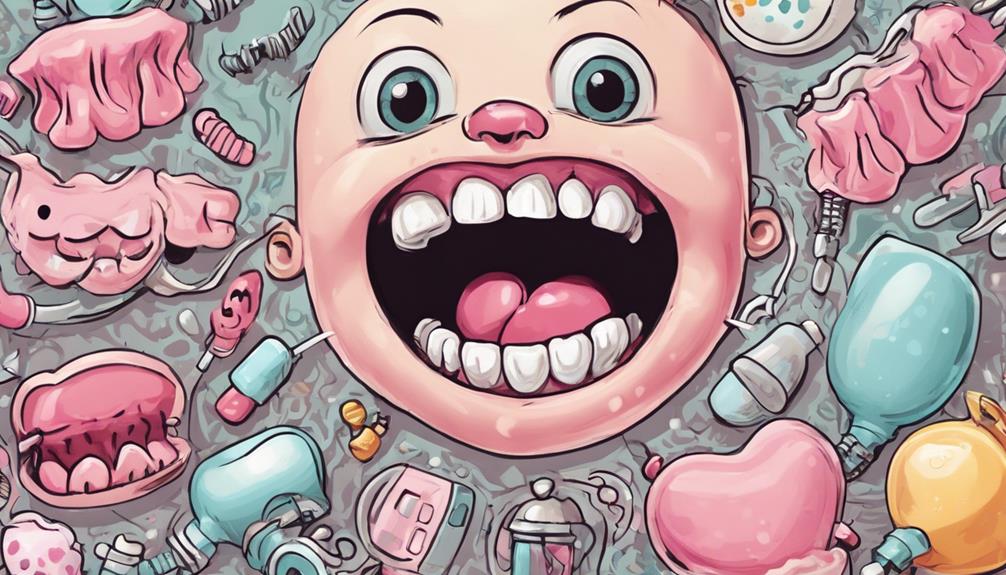
Understanding the timeline of tooth eruption helps you anticipate when to expect those first little teeth, making the teething journey a bit smoother for both you and your baby. Typically, teething begins around 6 months, but some babies might start as early as 3 months or as late as 12 months.
Here's a quick reference table for the order of baby teeth eruption:
| Tooth Type | Eruption Age (Months) |
|---|---|
| Lower Central Incisors | 6-10 |
| Upper Central Incisors | 8-12 |
| Lateral Incisors | 9-13 |
The first teeth to emerge are usually the lower central incisors. Following that, you can expect the upper central incisors to come in. Over the next few years, your baby will develop a complete set of 20 primary teeth, with the lateral incisors appearing next, followed by molars and canines. By age 3, most children will have their full set of primary teeth, setting the stage for their future dental development.
Signs of Teething
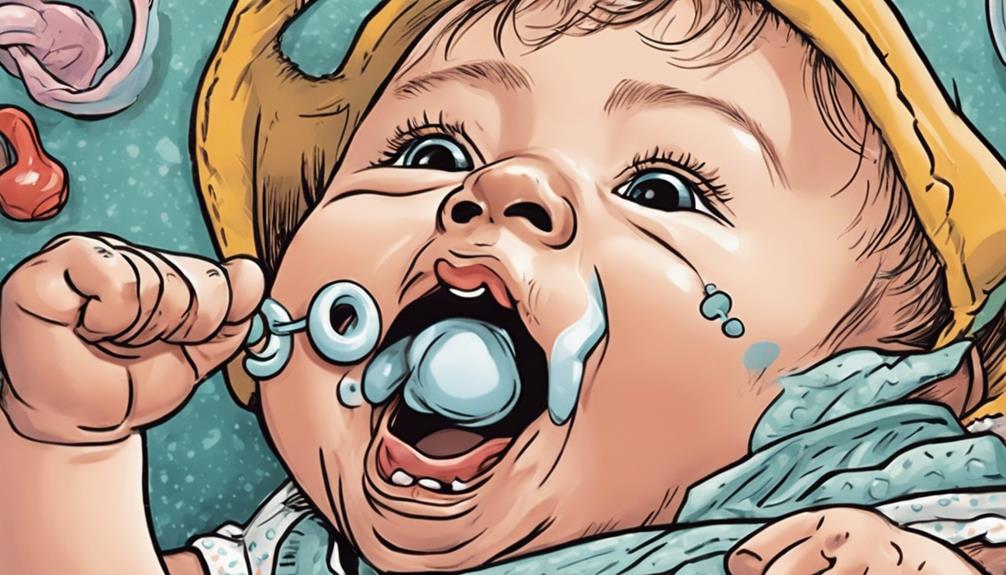
When your baby starts teething, you might notice common symptoms like increased drooling and fussiness.
It's important to distinguish these signs from other illnesses, as some symptoms can overlap.
Understanding how to manage teething discomfort can make this process easier for both you and your little one.
Common Teething Symptoms
Many parents notice several common symptoms that signal their baby is teething, including increased drooling and irritability. Drooling often starts around 3 months of age as your baby's body responds to teeth pushing through the gums. You might also see signs of discomfort, like fussiness, especially in the days leading up to a tooth's eruption.
Swollen and tender gums are frequent indicators of teething. If you look closely, you may notice that the area around the emerging tooth appears red or inflamed. In some cases, infants might have a slight increase in temperature, but it's usually less than 102°F. Remember, a high fever isn't typically associated with teething and could suggest another illness.
Additionally, teething can disrupt your baby's sleep patterns, making it harder for them to fall asleep or causing them to wake more frequently at night. Understanding these common symptoms can help you provide comfort and care during this challenging phase of your baby's development.
Distinguishing Other Illnesses
Distinguishing teething symptoms from signs of other illnesses is essential for ensuring your baby's well-being. While teething can cause irritability and swollen gums, you need to be vigilant about other potential health issues. Here are some key differences to evaluate:
- Fever: A slight rise in temperature (under 100.4°F) can occur during teething. However, a true fever exceeding this threshold usually indicates a medical issue, like an infection.
- Pain Severity: Teething may cause discomfort, but if your baby shows severe pain or persistent crying, it's time to consult a healthcare provider.
- Eating and Sleeping Patterns: Changes in these patterns are typical during teething. If you notice prolonged disruptions, seek a consultation to rule out other conditions.
- Additional Symptoms: Look out for signs like fluid discharge or balance issues, which are more aligned with ear infections than teething.
Managing Teething Discomfort
Recognizing the signs of teething can help you manage your baby's discomfort effectively. Common signs and symptoms include increased drooling, irritability, and a strong desire to chew on objects. You might also notice swollen gums and disrupted sleep patterns as your baby goes through this phase.
Here's a quick reference table to help you identify and manage teething discomfort:
| Signs and Symptoms | Management Tips | When to Consult a Doctor |
|---|---|---|
| Increased drooling | Use teething rings to soothe teething | High fever (over 102°F) |
| Irritability | Offer cold washcloths to chew on | Severe pain or swelling |
| Disrupted sleep | Maintain a consistent bedtime routine | Persistent symptoms after a week |
During this time, soft foods can help if your baby's appetite decreases. Teething rings are particularly effective in easing discomfort. Remember, while some discomfort is normal, keep an eye out for symptoms that may suggest other health issues. If you're concerned, don't hesitate to reach out to your pediatrician for guidance.
Common Teething Remedies

Teething can be tough for babies, but there are effective remedies to help soothe their discomfort. Here are some common teething remedies you can try:
- Teething Rings: Choose BPA-free teething rings for safety. These provide a safe object for your baby to chew on, helping to alleviate discomfort.
- Chilled Clean Washcloth: Chill a clean washcloth or teething ring in the fridge. The cold sensation offers soothing relief by numbing your baby's gums and reducing inflammation.
- Gum Massage: Gently massage your baby's gums with a clean finger. This can provide immediate comfort and relieve teething pain effectively.
- Natural Options: Consider natural options like chamomile tea for comfort. However, it's important to consult with a pediatrician before introducing any new remedies.
When using over-the-counter pain relief, exercise caution. Avoid teething gels with benzocaine for infants under 2 years due to potential side effects.
Oral Hygiene for Infants

Establishing a solid oral hygiene routine for your infant is essential, even before their first tooth emerges. Start by gently cleaning your baby's gums with a soft cloth or gauze after feedings. This early practice helps instill good oral hygiene habits that will benefit them later.
Once your infant's first tooth appears, switch to a soft-bristled toothbrush and brush it gently with a smear of fluoride toothpaste. It's important to promote dental health from the start. Pediatricians typically recommend introducing fluoride toothpaste after age 2 to help strengthen tooth enamel and prevent decay.
Regular dental check-ups should begin by age 1 or when the first tooth erupts. These visits allow the dentist to monitor your baby's oral health and development effectively.
Additionally, be mindful of nursing bottle decay. Avoid putting your baby to bed with a bottle, as this can lead to cavities.
Supervise your child's brushing routine until they're around age 7 or 8, ensuring they maintain proper technique. By following these steps, you set the foundation for a lifetime of healthy smiles.
Importance of Baby Teeth
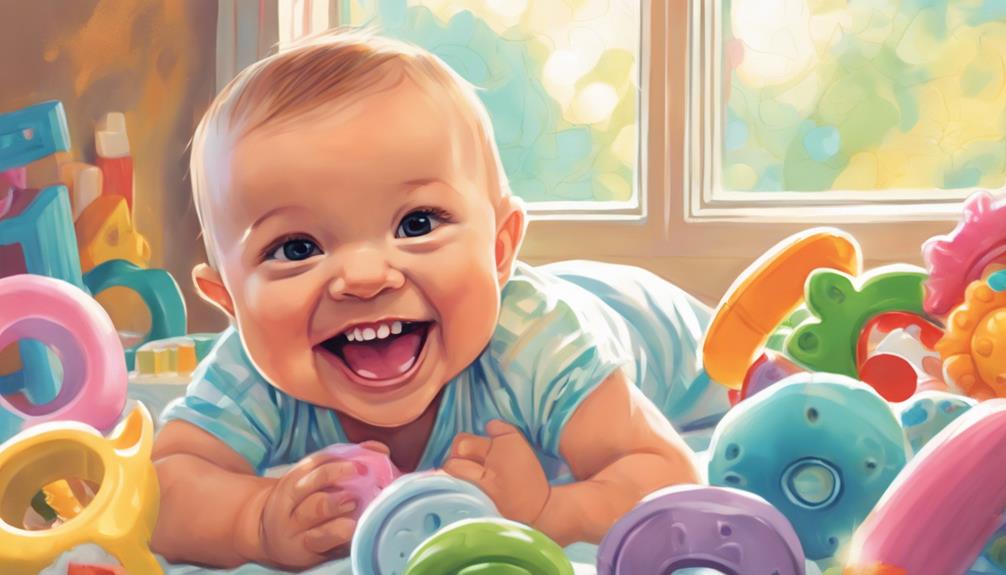
You mightn't realize it, but baby teeth are essential for your child's overall development.
They set the stage for permanent teeth while also playing a key role in speech and nutrition.
Foundation for Permanent Teeth
While they may seem temporary, baby teeth play an important role in laying the foundation for healthy permanent teeth by maintaining proper spacing and alignment in the mouth. These primary teeth not only provide a guide for the eruption of permanent teeth but also contribute greatly to your child's overall dental development.
Here are four key reasons why baby teeth are so important:
- Placeholder Role: Baby teeth guarantee there's enough space for permanent teeth to come in correctly.
- Dental Hygiene Habits: Establishing good dental hygiene practices early helps prevent cavities and promotes lifelong oral health.
- Nutrition Support: Healthy baby teeth enable effective chewing, which is essential for proper nutrition during those important early years.
- Speech Development: Functioning baby teeth assist in the formation of sounds, aiding clear speech and articulation.
Speech and Nutrition Development
Baby teeth play an important role in speech and nutrition development by enabling clear articulation and effective chewing. As your child's primary teeth emerge, they provide the necessary structure for proper speech development, allowing them to pronounce sounds clearly. Baby teeth are also vital for helping children learn how to chew properly, which is essential for proper digestion and nutrient absorption. Additionally, baby teeth act as placeholders for the permanent teeth, guiding them into the correct position as they grow in. This is why it’s important to take good care of what baby teeth are and ensure they remain healthy and strong.
Healthy baby teeth are essential for effective chewing, which is significant for a balanced diet and proper nutrition during these formative years. When your child has healthy baby teeth, it helps maintain space in the jaw for adult teeth, ensuring that those permanent teeth can emerge with proper alignment.
This alignment is crucial, as misaligned teeth can lead to challenges in pronouncing certain sounds and words, impacting overall speech development. Moreover, baby teeth encourage your little one to practice chewing different textures, which promotes healthy eating habits.
The ability to chew a variety of foods is instrumental in fostering a love for nutritious options. Prioritizing dental health during this stage not only supports speech and nutrition but also lays a strong foundation for your child's overall well-being as they grow.
Pediatrician Recommendations
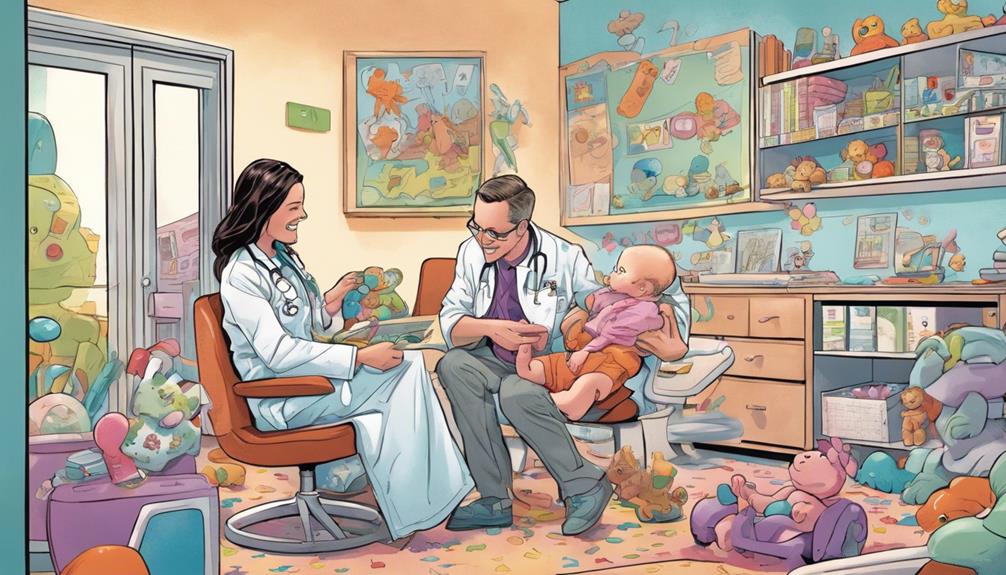
Pediatricians recommend scheduling your child's first dental visit as soon as their first tooth erupts or by their first birthday to guarantee proper dental development. This early visit is essential for monitoring oral health and establishing good habits.
Here are some key recommendations to keep in mind:
- Start Early: Begin oral care routines as soon as your child's first tooth appears. Use a soft-bristled toothbrush and fluoride toothpaste.
- Fluoride Varnish: Ask your pediatrician about fluoride varnish applications after your child's teeth start coming in to help prevent tooth decay.
- Healthy Diet: Limit sugary foods and beverages in your child's diet to reduce the risk of cavities. Healthy snacks can support dental health.
- Teething Concerns: If your child experiences teething symptoms, consult your pediatrician about pain relief options and what's appropriate for their age.
First Dental Visit

Scheduling your child's first dental visit is essential for ensuring a healthy start to their oral development. Ideally, you should schedule this visit after their first tooth erupts or by their first birthday, whichever comes first.
Choosing a pediatric dentist is important, as they provide specialized care tailored to young children and guide you on effective oral hygiene practices.
At this initial visit, the dentist will assess your child's teeth and gums, discuss teething, and address any concerns you may have.
Establishing a 'dental home' by age one is recommended, as it supports ongoing monitoring and preventive care throughout your child's growth.
Regular dental check-ups can help detect early signs of dental issues, allowing for timely intervention and treatment.
Stages of Teething
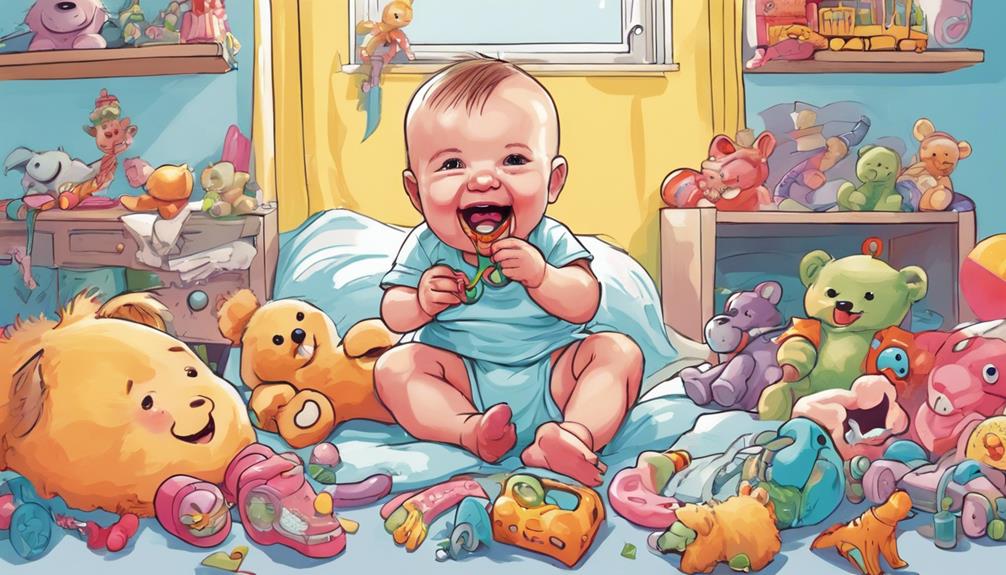
When it comes to teething, you'll notice your baby goes through five distinct stages, each bringing its own symptoms.
From the initial eruption of incisors to the emergence of molars, being aware of these stages can help you understand what your little one is experiencing.
Let's explore how teething progresses and what signs to look for at each age.
Teething Stages Overview
Teething is a gradual process that unfolds in distinct stages, each marked by specific developments and challenges as your baby's teeth begin to emerge. Understanding these teething stages can help you navigate through this changeable time smoothly.
- Stage 1 (0-6 months): All 20 primary teeth are formed in the jaw, but none have erupted yet. Your baby primarily consumes milk during this time.
- Stage 2 (6-8 months): The first teeth, typically the lower central incisors, begin to erupt. You might notice increased drooling and your baby may chew on objects for relief.
- Stage 3 (10-14 months): Primary molars start to emerge, often leading to crankiness, decreased appetite, and disrupted sleep patterns as your baby adjusts to these new teeth.
- Stage 4 (16-22 months): Canine teeth surface during this stage. You'll want to use soothing methods that have worked previously to help alleviate any discomfort.
As your baby starts teething, being aware of these stages allows you to provide the necessary support and comfort, making the experience a little easier for both of you.
Symptoms by Age Group
As your baby progresses through each teething stage, you'll notice distinct symptoms that can help you understand their discomfort and provide appropriate relief.
In the first stage (0-6 months), your baby has a full set of 20 primary teeth formed in the jaw, but no teeth have erupted yet. During this time, they may seem fussy, but the discomfort is less pronounced.
In stage two (6-8 months), expect increased drooling and a strong desire to chew on objects as the central incisors start to emerge. This can cause sore gums and irritability.
As your baby reaches stage three (10-14 months), the first molars come in, often leading to noticeable irritability, loss of appetite, and disruptions in sleep.
Unsafe Teething Products
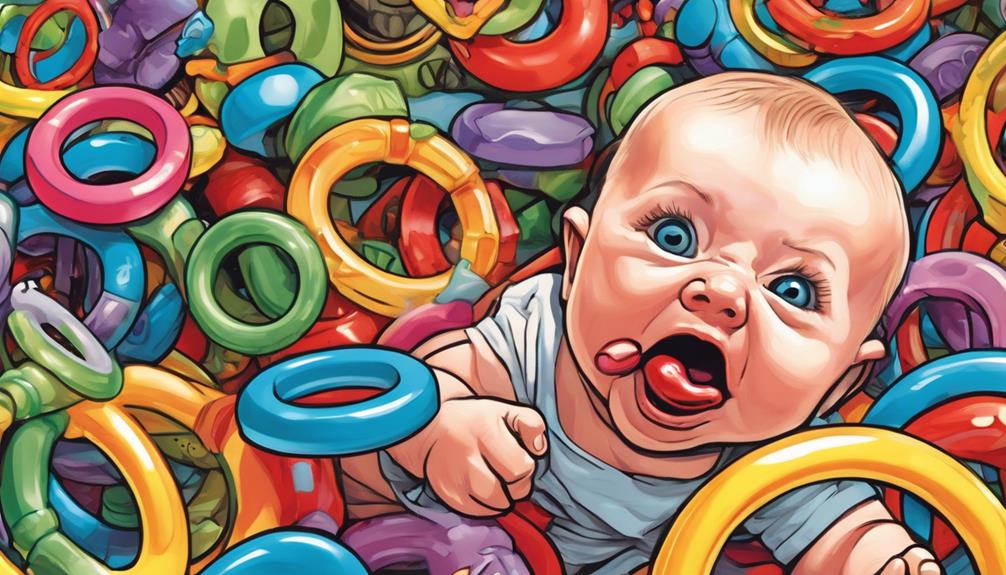
Many popular teething products, such as certain tablets and necklaces, pose serious safety risks for infants. It's vital to be aware of which products are unsafe to guarantee your child's health and well-being. Here are some products you should avoid:
- Teething tablets: Many contain belladonna or benzocaine, which can lead to severe side effects. The FDA has warned against their use.
- Amber teething necklaces: These necklaces can cause choking or strangulation and lack scientific evidence for relieving teething pain.
- Liquid-filled teething rings: If they break or leak, they can create a choking hazard for your little one.
- Unapproved teething products: Always check if the product has been approved for safety by pediatricians or relevant authorities.
Before using any over-the-counter teething remedies, it's important to consult with a pediatrician. They can help you navigate the options that are safe and effective for your infant.
Frequently Asked Questions
When Do Teeth Come in a Baby?
Teeth typically start coming in between 6 to 12 months. You might notice the lower central incisors first, followed by upper ones, but remember, every baby's timeline can vary quite a bit.
What Age Do Babies Get Teeth?
Imagine tiny stars breaking through the night sky; that's when your baby starts teething. Typically, you'll notice their first teeth around 6 months, though some might surprise you as early as 3 or as late as 12 months.
How Many Teeth Does a Baby Have?
When you ask how many teeth a baby has, remember that they typically have 20 primary teeth hidden in their jaws. Most start appearing around 6 to 12 months, but timelines can vary widely.
What Order Do Teeth Come in for Babies?
Teeth typically come in a specific order for babies. First, you'll notice the lower central incisors, followed by upper central incisors, then lateral incisors, molars, canines, and finally, the second molars by age three.
Conclusion
So, congratulations! Your little one's about to initiate their toothy adventure, turning them into a miniature version of a piranha.
Just when you thought you'd found the perfect baby, they'll start drooling like a leaky faucet and gnawing on everything in sight.
Keep your dental toolkit ready—because those pearly whites won't just show up without a bit of fuss.
Remember, while teething might be a circus act, you're the ringmaster! Enjoy the show!
